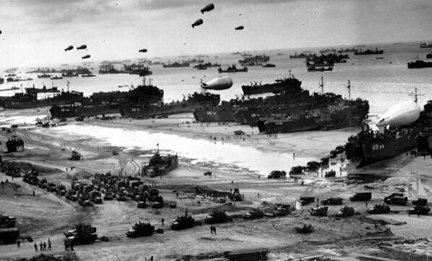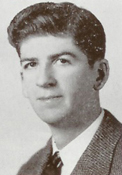
Inset: Bert J. Borrone
June 6: the 75th anniversary of D-Day, the best- and worst-kept secret of World War II.
It was 1944, and everyone knew this would be “the year of destiny,” when the Allies would launch a massive cross-channel invasion of Europe to mark the beginning of the end for Nazi Germany. But until it happened, no one knew precisely when or where the assault would take place.
Bowling Green’s Bert Borrone was deeply interested in the question. Stationed with a signal service company in North Africa, the U.S. Army sergeant was responsible for radio broadcasts that would keep his military audience informed about the course of the war. Late in May 1944, he prepared two 15-minute programs for the American Expeditionary Station News Bureau to ready his listeners for the invasion, “so that when the day does come. . . and General Eisenhower says ‘Tonight, we strike,’ we shall be able to follow the hourly news, be it good or bad, with understanding, with confidence.”
Borrone’s first program painted a vivid picture of the invasion landscape: the English Channel, both a “ready-made highway for assault” and “an itinerary to death”; the minesweepers, those “unsung old ladies of the sea,” spearheading the fleet; the arc of invasion vessels stretching across the horizon; the bombers, fighters and paratroop transports. Beaches were necessary to land troops, and ports to supply them, but “no one knows better than the Nazi what is potential invasion land,” Borrone warned. The enemy would be ready with mines, landing-craft traps, anti-tank obstacles, machine-gun and mortar emplacements, pill-boxes, bunkers, fortified towns and “hundreds of thousands of the Wehrmacht’s finest, dug in for the showdown.”
Then would come the landings, as “battle-wagons, with their escorts of the sea and air, plunge toward the pre-assigned beaches,” and all the plans, rehearsals and calculations were put to the test. Many had performed their duties in advance: if Nazi fighters or weapons failed to appear, or if the enemy’s reserves arrived too late, or if his mines failed to detonate, it was because a production facility had been bombed day and night, or an intelligence operative had directed just where to place an explosive, or an underground fighter—“a Hans or a Pierre or an Emil”—had carried out a successful sabotage. Ultimately, however, the invasion would be “committed into the hands, and wits, and guts, of a few hundred thousand.”
Borrone’s second program was a tutorial on the tactics of a coastal invasion, the nuts-and-bolts calculations of everything from enemy firepower and types of forces needed to anticipated numbers of sea-sickness among the troops. Tides, terrain, defenses, roads, availability of reserves, and the timing, makeup and objectives of each “wave” of the invasion—these and other innumerable considerations, Borrone explained, needed to be weighed “against the single most important factor in any military action . . . initial, tactical surprise. Only then,” he declared, “can the supreme commander point his finger at one definitive spot along all the vast shore line and commit it irrevocably to the fates who weave human destiny.”
Bert Borrone’s radio broadcast scripts delivered in anticipation of D-Day are part of the Manuscripts & Folklife Archives of WKU’s Department of Library Special Collections. Click here for a finding aid. For more collections on World War II and D-Day, search TopSCHOLAR and KenCat.


